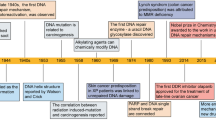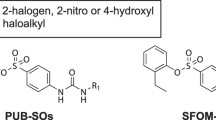Abstract
For DNA targeting anticancer drugs, cellular DNA repair mechanisms may cause resistance and hamper the therapeutic outcome. DNA damage induced by topoisomerase IIα inhibitors like etoposide and anthracyclines, which are a mainstay of cancer therapy, is also repaired in many cell types, but the impact and precise mechanisms of this repair are still obscure. To investigate the DNA damage response of human adenocarcinoma HT29-cells to doxorubicin and to compare the involvement of Ku70 and Rad51 in the repair of doxorubicin- versus etoposide-induced DNA damage, we assessed cell cycle distribution and cell death, DNA damage, proteins relevant for repair by homologous recombination and non-homologous end-joining, and clonogenicity following exposure to doxorubicin at clinically achievable concentrations. Also, we assessed changes in the repair kinetics after siRNA-mediated attenuation of Ku70 or Rad51 expression. We found that exposure to doxorubicin for 24 h induced a substantial amount of DNA damage that was largely repaired when doxorubicin was removed and the cells were maintained in drug-free medium. Nevertheless, a pronounced G2/M arrest occurred at times when repair was maximal. This was followed by a distinct increase in cell death and loss of clonogenicity. In this regard, responses to doxorubicin and etoposide were similar. However, distinct differences in the repair process following doxorubicin versus etoposide were seen in concentration dependency, time-course and requirement of Ku70 and Rad51 proteins. In spite of the shared molecular target of doxorubicin and etoposide, DNA lesions induced by these compounds are repaired differently.





Similar content being viewed by others
References
Jeggo PA, Lobrich M (2006) Contribution of DNA repair and cell cycle checkpoint arrest to the maintenance of genomic stability. DNA Repair (Amst) 5:1192–1198. doi:10.1016/j.dnarep.2006.05.011
Rothkamm K, Kuhne M, Jeggo PA, Lobrich M (2001) Radiation-induced genomic rearrangements formed by nonhomologous end-joining of DNA double-strand breaks. Cancer Res 61:3886–3893
Zhang Y, Rowley JD (2006) Chromatin structural elements and chromosomal translocations in leukemia. DNA Repair (Amst) 5:1282–1297. doi:10.1016/j.dnarep.2006.05.020
Schonn I, Hennesen J, Dartsch DC (2010) Cellular responses to etoposide: cell death despite cell cycle arrest and repair of DNA damage. Apoptosis 15:162–172. doi:10.1007/s10495-009-0440-9
Hande K (1998) Etoposide: four decades of development of a topoisomerase II inhibitor. Eur J Cancer 34:1514–1521. doi:10.1016/S0959-8049(98)00228-7
Liu LF, Rowe TC, Yang L, Tewey KM, Chen GL (1983) Cleavage of DNA by mammalian DNA topoisomerase II. J Biol Chem 258:15365–15370
Capranico G, Binaschi M, Borgnetto M, Zunino F, Palumbo M (1997) A protein-mediated mechanism for the DNA sequence-specific action of topoisomerase II poisons. TiPS 18:323–329
Binaschi M, Capranico G, Dal Bo L, Zunino F (1997) Relationship between lethal effects and topoisomerase II-mediated double-stranded DNA breaks produced by anthracyclines with different sequence specificity. Mol Pharmacol 51:1053–1059
Zunino F, Capranico G (1990) DNA topoisomerase II as the primary target of anti-tumor anthracyclines. Anticancer Drug Des 5:307–317
Gewirtz DA (1999) A critical evaluation of the mechanisms of action proposed for the antitumor effects of the anthracycline antibiotics adriamycin and daunorubicin. Biochem Pharmacol 57:727–741
Coldwell K, Cutts SM, Ognibene TJ, Henderson PT, Phillips DR (2010) Detection of adriamycin-DNA adducts by accelerator mass spectrometry. Methods Mol Biol 613:103–118. doi:10.1007/978-1-60327-418-0_7
Tapiero H, Nguyen-Ba G, Lampidis TJ (1994) Cross resistance relevance of the chemical structure of different anthracyclines in multidrug resistant cells. Pathol Biol (Paris) 42:328–337
Blasiak J, Widera K, Pertynski T (2003) Hyperthermia can differentially modulate the repair of doxorubicin-damaged DNA in normal and cancer cells. Acta Biochim Pol 50:191–195
Dartsch DC, Gieseler F (2007) Repair of idarubicin-induced DNA damage: a cause of resistance? DNA Repair (Amst) 6:1618–1628. doi:10.1016/j.dnarep.2007.05.007
Gieseler F, Nussler V, Brieden T, Kunze J, Valsamas S (1998) Intracellular pharmacokinetics of anthracyclines in human leukemia cells: correlation of DNA-binding with apoptotic cell death. Int J Clin Pharmacol Ther 36:25–28
Maniar N, Krishan A, Israel M, Samy TS (1988) Anthracycline-induced DNA breaks and resealing in doxorubicin-resistant murine leukemic P388 cells. Biochem Pharmacol 37:1763–1772
Zhijian C, Xiaoxue L, Yezhen L, Shijie C, Lifen J, Jianlin L, Deqiang L, Jiliang H (2010) Impact of 1.8-GHz radiofrequency radiation (RFR) on DNA damage and repair induced by doxorubicin in human B-cell lymphoblastoid cells. Mutat Res 695:16–21. doi:10.1016/j.mrgentox.2009.10.001
D’Arpa P, Beardmore C, Liu L (1990) Involvement of nucleic acid synthesis in cell killing mechanisms of topoisomerase poisons. Cancer Res 50:6919–6924
Haber JE (2000) Partners and pathways repairing a double-strand break. Trends Genet 16:259–264
Iliakis G (2009) Backup pathways of NHEJ in cells of higher eukaryotes: cell cycle dependence. Radiother Oncol 92:310–315. doi:10.1016/j.radonc.2009.06.024
Wyman C, Warmerdam DO, Kanaar R (2008) From DNA end chemistry to cell-cycle response: the importance of structure, even when it’s broken. Mol Cell 30:5–6. doi:10.1016/j.molcel.2008.03.007
Connelly JC, Leach DR (2004) Repair of DNA covalently linked to protein. Mol Cell 13:307–316
Zhang A, Lyu YL, Lin CP, Zhou N, Azarova AM, Wood LM, Liu LF (2006) A protease pathway for the repair of topoisomerase II-DNA covalent complexes. J Biol Chem 281:35997–36003. doi:10.1074/jbc.M604149200
Capranico G, Kohn KW, Pommier Y (1990) Local sequence requirements for DNA cleavage by mammalian topoisomerase II in the presence of doxorubicin. Nucleic Acids Res 18:6611–6619
Pommier Y, Capranico G, Orr A, Kohn KW (1991) Local base sequence preferences for DNA cleavage by mammalian topoisomerase II in the presence of amsacrine or teniposide. Nucleic Acids Res 19:5973–5980
Morin PJ, Vogelstein B, Kinzler KW (1996) Apoptosis and APC in colorectal tumorigenesis. Proc Natl Acad Sci USA 93:7950–7954
Blandino G, Levine AJ, Oren M (1999) Mutant p53 gain of function: differential effects of different p53 mutants on resistance of cultured cells to chemotherapy. Oncogene 18:477–485
Chang FL, Lai MD (2001) Various forms of mutant p53 confer sensitivity to cisplatin and doxorubicin in bladder cancer cells. J Urol 166:304–310
Eksborg S, Strandler H-S, Edsmyr F, Näslund I, Tahvanainen P (1985) Pharmacokinetic study of IV infusions of adriamycin. Eur J Clin Pharmacol 28:205–212
Giaccone G, Linn S, Welink J, Catimel G, Stieltjes H, Van der Vijgh W, Eeltink C, Vermorken J, Pinedo H (1997) A dose-finding and pharmacokinetic study of reversal of multidrug resistance with SDZ PSC 833 in combination with doxorubicin in patients with solid tumors. Clin Cancer Res 3:2005–2015
Greene R, Collins J, Jenkins J, Speyer J, Myers C (1983) Plasma pharmacokinetics of adriamycin and adriamycinol: implications for the design of in vitro experiments and treatment protocols. Cancer Res 43:3417–3421
Mross K, Mayer U, Hamm K, Burk K, Hossfeld D (1990) Pharmacokinetics and metabolism of iodo-doxorubicin and doxorubicin in humans. Eur J Clin Pharmacol 39:507–513
Speth P, Linssen P, Termond E, Boezeman J, Wessels H, Haanen C (1989) In vivo and in vitro pharmacokinetic differences between four structurally closely related anthracyclines in hematopoetic cell subtypes in humans. Drug Metab Dispos 17:98–105
Zhu G, Gilchrist R, Borley N, Chng H, Morgan M, Marshall J, Camplejohn R, Muir G, Hart I (2004) Reduction of TSG101 protein has a negative impact on tumor cell growth. Int J Cancer 109:541–547. doi:10.1002/ijc.20014
Dartsch D, Schaefer A, Boldt S, Kolch W, Marquardt H (2002) Comparison of anthracycline-induced death of human leukemia cells: programmed cell death versus necrosis. Apoptosis 7:537–548. doi:10.1023/A:1020647211557
Collins AR, Oscoz AA, Brunborg G, Gaivao I, Giovannelli L, Kruszewski M, Smith CC, Stetina R (2008) The comet assay: topical issues. Mutagenesis 23:143–151. doi:10.1093/mutage/gem051
Olive PL, Banath JP (2006) The comet assay: a method to measure DNA damage in individual cells. Nat Protoc 1:23–29. doi:10.1038/nprot.2006.5
Bar-On O, Shapira M, Hershko DD (2007) Differential effects of doxorubicin treatment on cell cycle arrest and Skp2 expression in breast cancer cells. Anticancer Drugs 18:1113–1121
Lee SM, Youn B, Kim CS, Kim CS, Kang C, Kim J (2005) Gamma-irradiation and doxorubicin treatment of normal human cells cause cell cycle arrest via different pathways. Mol Cells 20:331–338
Robles SJ, Buehler PW, Negrusz A, Adami GR (1999) Permanent cell cycle arrest in asynchronously proliferating normal human fibroblasts treated with doxorubicin or etoposide but not camptothecin. Biochem Pharmacol 58:675–685
Venkatakrishnan CD, Dunsmore K, Wong H, Roy S, Sen CK, Wani A, Zweier JL, Ilangovan G (2008) HSP27 regulates p53 transcriptional activity in doxorubicin-treated fibroblasts and cardiac H9c2 cells: p21 upregulation and G2/M phase cell cycle arrest. Am J Physiol Heart Circ Physiol 294:H1736–H1744. doi:10.1152/ajpheart.91507.2007
Kim HS, Lee YS, Kim DK (2009) Doxorubicin exerts cytotoxic effects through cell cycle arrest and Fas-mediated cell death. Pharmacology 84:300–309. doi:10.1159/000245937
Malugin A, Kopeckova P, Kopecek J (2007) Liberation of doxorubicin from HPMA copolymer conjugate is essential for the induction of cell cycle arrest and nuclear fragmentation in ovarian carcinoma cells. J Control Release 124:6–10
Puri PL, Medaglia S, Cimino L, Maselli C, Germani A, De Marzio E, Levrero M, Balsano C (1997) Uncoupling of p21 induction and MyoD activation results in the failure of irreversible cell cycle arrest in doxorubicin-treated myocytes. J Cell Biochem 66:27–36
Banath JP, Klokov D, MacPhail SH, Banuelos CA, Olive PL (2010) Residual gammaH2AX foci as an indication of lethal DNA lesions. BMC Cancer 10:4. doi:10.1186/1471-2407-10-4
Speth PA, Raijmakers RA, Boezeman JB, Linssen PC, de Witte TJ, Wessels HM, Haanen C (1988) In vivo cellular adriamycin concentrations related to growth inhibition of normal and leukemic human bone marrow cells. Eur J Cancer Clin Oncol 24:667–674
Zhang XP, Liu F, Cheng Z, Wang W (2009) Cell fate decision mediated by p53 pulses. Proc Natl Acad Sci USA 106:12245–12250. doi:10.1073/pnas.0813088106
Binaschi M, Capranico G, De Isabella P, Mariani M, Supino R, Tinelli S, Zunino F (1990) Comparison of DNA cleavage induced by etoposide and doxorubicin in two human small-cell lung cancer lines with different sensitivities to topoisomerase II inhibitors. Int J Cancer 45:347–352
Martensson S, Nygren J, Osheroff N, Hammarsten O (2003) Activation of the DNA-dependent protein kinase by drug-induced and radiation-induced DNA strand breaks. Radiat Res 160:291–301
Muslimovic A, Nystrom S, Gao Y, Hammarsten O (2009) Numerical analysis of etoposide induced DNA breaks. PLoS One 4:e5859. doi:10.1371/journal.pone.0005859
Pohl TJ, Nickoloff JA (2008) Rad51-independent interchromosomal double-strand break repair by gene conversion requires Rad52 but not Rad55, Rad57, or Dmc1. Mol Cell Biol 28:897–906. doi:10.1128/MCB.00524-07
Bahmed K, Nitiss KC, Nitiss JL (2010) UnTTrapping the ends: a new player in overcoming protein linked DNA damage. Cell Res 20:122–123. doi:10.1038/cr.2010.17
Kurz EU, Leader KB, Kroll DJ, Clark M, Gieseler F (2000) Modulation of human DNA topoisomerase IIalpha function by interaction with 14-3-3epsilon. J Biol Chem 275:13948–13954. doi:10.1074/jbc.275.18.13948
Mao Y, Desai SD, Ting CY, Hwang J, Liu LF (2001) 26 S proteasome-mediated degradation of topoisomerase II cleavable complexes. J Biol Chem 276:40652–40658. doi:10.1074/jbc.M104009200
Salmena L, Lam V, McPherson J, Goldenberg G (2001) Role of proteasomal degradation in the cell cycle-dependent regulation of DNA topoisomerase IIalpha expression. Biochem Pharmacol 61:795–802
Acknowledgments
We would like to thank Prof. Dr. Frank Gieseler from the University Hospital Luebeck for many helpful discussions. Our work was supported by the Ernst und Elfriede Griebel’s Foerderungs- und Unterstuetzungsstiftung, Hamburg.
Conflict of interest
The authors declare that they have no conflict of interest.
Author information
Authors and Affiliations
Corresponding author
Rights and permissions
About this article
Cite this article
Schonn, I., Hennesen, J. & Dartsch, D.C. Ku70 and Rad51 vary in their importance for the repair of doxorubicin- versus etoposide-induced DNA damage. Apoptosis 16, 359–369 (2011). https://doi.org/10.1007/s10495-010-0564-y
Published:
Issue Date:
DOI: https://doi.org/10.1007/s10495-010-0564-y




